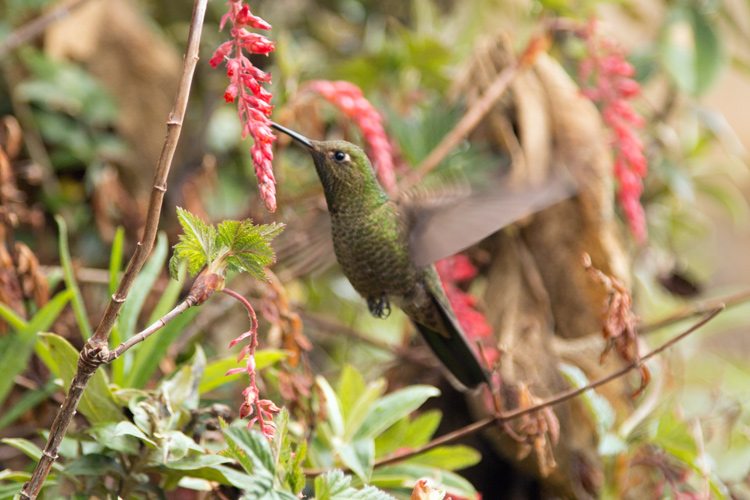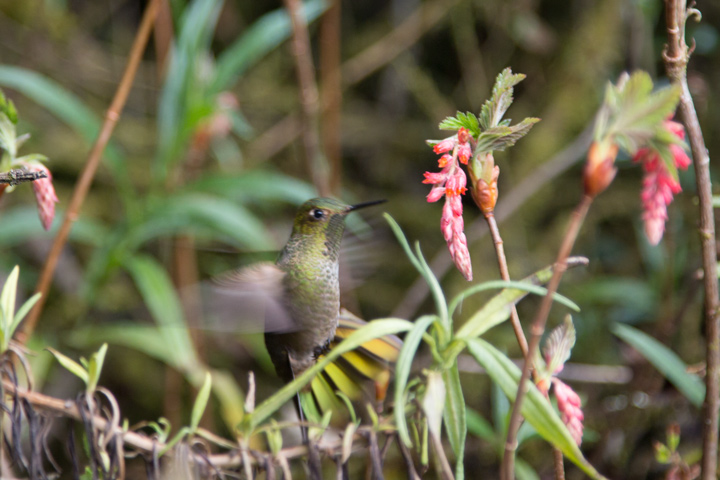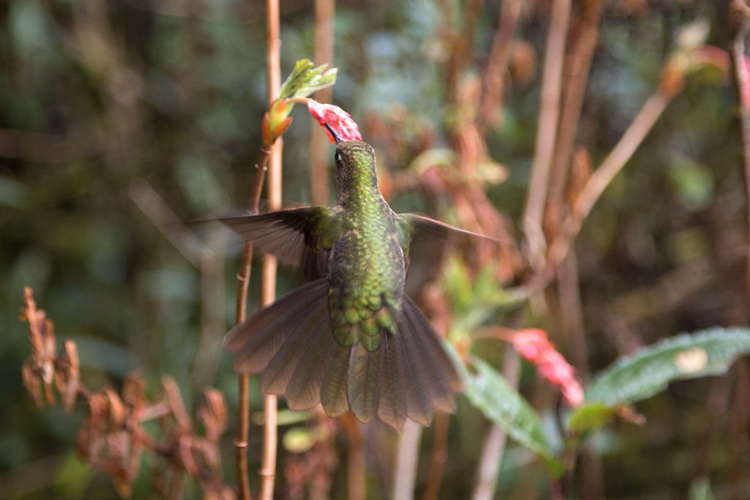Ninth in a series about the Inca Trail
Growing up with a half dozen birdfeeders in my backyard, I was quite the avid birder in my youth. In fact, my first part-time job was at a Wild Bird Center in my hometown. Identifying hummingbirds is pretty easy on the East Coast of North America, where there is only one native species, the ruby-throated hummingbird. Aside from a wild card in the form of the occasional West Coast hummer that somehow made a navigational error, if you see a hummingbird on the Atlantic seaboard, you can safely assume it is in fact a ruby-throated hummingbird.
Birders in most of the rest of the Western Hemisphere have it a little more difficult. On the West Coast of North America as well as in Central and South America, there is a wide diversity among species. Species identification can be difficult, especially distinguishing among the females of different species…many are virtually identical in appearance. (I vaguely remember a tongue-in-cheek article from about 15 years ago in Bird Watcher’s Digest entitled something like “Birding in Hell” in which wicked birders found themselves damned to, among other things, have to identify female hummingbirds.) Peru has an especially great variety of different hummingbirds, almost 100. One of the famous Nazca Lines depicts a hummingbird.
My academic wife claims I can technically be guilty of plagiarizing myself (!), so let this serve as notice that the next three paragraphs are adapted from one of my previous articles on our Inca Trail hike.
On Day Three of the trek, we arrived at Runkuraqay Pass, the second of three on the trail to Machu Picchu. During a ceremony at the pass, our guide Percy told a story. All the animals were fleeing a wildfire, he said. A deer saw a hummingbird flying towards the fire instead of away, and asked the bird why he was being so foolish.
“At least I’m doing my part,” replied the hummingbird. The hummingbird was going down to the water, filling its bill, and then dropping the water on the fire.

After the ceremony, we put our packs back on and began descending the trail on the far side of the pass. In the distance, the mountains were densely forested (the beginning of the Amazon rainforest, according to Percy). I was surprised when a small hummingbird began feeding on flowers along the trail not a meter in front of me. It was incredible being so close to this fearless bird. It was an especially interesting sighting given the story we’d just heard. Although not every photo I took of it was sharp, I was able to almost fill the frame with only a 105 mm lens (though for the web, these are slightly cropped).

I figured the photos would be suitable for identification purposes. When I got home, I consulted an 82-page book I’d purchased for 65 soles (about $19) in Cusco, Birds of Cusco and Machu Picchu. The book had decent photos and bilingual text. I thought it would have the most common birds I could have expected to encounter hiking in the area. Unfortunately, I found it was almost useless.
Although Birds of Cusco and Machu Picchu depicts about 150 species, it didn’t have the handful of species I was trying to identify from photographs. Of the 13 hummingbirds the book depicted, only the white-bellied hummingbird looked close in terms of overall coloration and the white around the eye. Unfortunately the bill and tail looked different in the bird depicted in my photographs.
I bit the bullet and purchased the Princeton Field Guides Birds of Peru ($29.97 on Amazon). This massive 664-page tome is way too large and heavy to properly be called a field guide, but it boasted that it “features every one of Peru’s 1,817 bird species and shows the distinct plumages of each in 307 superb, high-quality color plates.” (Update on July 21, 2016: More portable—but at $34.99 rather expensive—a Birds of Peru iPhone ap based on the book was just released.)

As promised, this guide was actually quite useful. I retained enough birding knowledge to get a rough idea of a bird’s family from its shape. It took mere minutes to identify the scarlet-bellied mountain-tanager I’d seen on Day Two or the Andean guan I’d seen on Day Four.
The hummingbird was a bit more difficult. The book spent 38 pages on hummingbirds…93 different species, by my count. I could eliminate species that weren’t found in the Cuzco department since Peru’s 24 departments were depicted on range maps of each species. Since it was a rather ordinary looking species, I could also rule out the fairly spectacular looking (if ridiculously named) species like the marvelous spatuletail, fork-tailed woodnymph, shining sunbeam, violet-throated starfrontlet, green-tailed trainbearer, and the booted racket-tail. (Some ornithologists were clearly having some fun when they decided on South American hummingbirds’ common names in English.)
During my first pass through the book, I didn’t see anything that really resembled the bird. It doesn’t help that hummingbirds often have rather iridescent feathers that change appearance depending on light and the angle. For instance, looking at the photo I already presented, you would say this hummingbird was green all over, right? No indication of a white breast. One would also say the throat is similar in color to the rest of the body. Here’s the photo again:

But from another angle, the bird clearly does have different coloring on its breast and throat:

Arg. It’s really too much to expect even the most talented painter to display all the various appearances of such a bird in a single painting. I did some internet searches for Inca Trail hummingbirds. I came across some photos identified as a female scaled metaltail that looked quite similar. The shape was right, the white near the eye, and the overall coloration. Of course, I had to be careful since the websites were not necessarily authoritative and could have misidentified the birds in their photos.
I went back to Birds of Peru. The scaled metaltail was indeed in the book. Only the male of the species was depicted, which could have explained why I hadn’t seen it looking through the book. The bird was listed as 11 cm (4.25 in) in length, which was about right (I’d have said 8 cm or 3 in). The bird did live in the Cuzco department. However, the guide described the bird as “uncommon” and found at an altitude of 2,750-3,600 m (9,022-11,811 ft).
The bird I’d photographed, however, was nearly 4,000 m or 13,123 ft high (to be precise, the GPS attached to my camera recorded an altitude of 3,977.3 m or 13,049 ft at position 13° 13′ 35.9″ S, 72° 30′ 20.4″ W when the pictures of the hummingbird were taken). Only a handful of Peruvian hummingbirds have been documented in ranges including altitudes that high (about ten by my count in Birds of Peru).
I briefly thought I might have simply been the first to prove the species lived at an altitude higher than previously documented before I remembered that these ornithologists probably knew more about this sort of thing than me. It was entirely possible that their information about those species found in more remote areas might be inaccurate, but a place as heavily traveled as the Inca Trail? Probably not.
I did think, however, that I was on the right track with the metaltails. As the name suggests, the birds have what the Birds of Peru guide calls a “metallic sheen to the tail, which is glittering green, purplish, or coppery.” And I had a photo of the bird with its tail spread:

I certainly would describe that as metallic in comparison with the green sheen of the rest of the body. With a second look, the bird did resemble the Tyrian metaltail (Metallura tyrianthina), although I think the paintings don’t make the identification a slam-dunk…there was a lot of variation among several subspecies, including ones with copper and ones with purple tails. It was listed has having a length of 9.5-10 cm (3.75-4 in), which seemed close. The range was right and it was found in the Andes from an altitude of 2,400 m to 4,200 m. The habitat was described as “humid montane forest” which sounded right. Perhaps most importantly, the guide described the bird as “Common; the most widely distributed metaltail.”
You may be able to examine Birds of Peru for the pages in question using Google Books (Tyrian metaltail is on pg. 246-247, scaled metaltail is on pg. 244-245).
Occam’s razor suggests that if I was pretty sure I’d seen a metailtail in Peru, it would be more likely to be the common species at an altitude it had been previously documented at range rather than the uncommon one that would have been 400 m too high! I’m fairly confident in the identification, but not certain. Most hummingbirds in Peru don’t range as high as 4,000 m, and of the ten or so that do, I didn’t see any others that matched better. Any reader with knowledge of this topic, feel free to confirm or refute my identification.
Incidentally, this article marks my last planned piece about the Inca Trail, a series I found almost as tough to write as the trail was to hike! There will be plenty more stories to tell from our travels in Bolivia and Peru, and I hope to cover my travels in Canada in the fall of 2014 that have been on the backburner until now.
Series on the Inca Trail (Camino Inka)
Planning a Trip to Bolivia and Peru (background)
Introduction (Cusco to Ollantaytambo by Bus)
Day One (Piscacucho to Wayllabamba)
12 km (7.5 mi) distance, +300 m (984 ft) elevation
Day Two (Wayllabamba to Pacamayo)
11 km (6.8 mi) distance, +1,200 m (3,937 ft)/-600 m (1,969 ft) elevation
Day Three (Part I, Pacamayo to Qunchamarka AND Part II, Chaquicocha to Wiñay Wayna)
15 km (9.3 mi) distance, +350 m (1,148 ft)/-1,300 m (4,265 ft) elevation
Day Four (Wiñay Wayna to Machu Picchu)
5 km (3.1 mi) distance, +40 m (131 ft)/-265 m (869 ft) elevation
Inca Trail’s End: Machu Picchu
The Inca Trail and Machu Picchu in Infrared
Identifying a Hummingbird at the Inca Trail’s Second Pass
